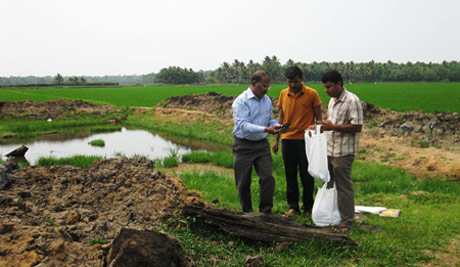The buried sub-fossil logs and peats in the wetlands of coastal plains and over bank areas offer an important source of information on environmental changes of the Holocene – the time span representing the last 10000 years of earth history. The local people in the coastal lands are familiar with the occurrence of this buried wood as it is often dug out and used as a source of fuel and/or timber for making furniture. However, such wood, buried in the shallow subsurface strata, has not attracted adequate attention of geoscientists or dendro- chronologists. The investigations of the research team comprising Dr.K.P.N. Kumaran and Dr.Ruta B. Limaye from Agharkar Research Institute (Pune), Dr.D. Padmalal and Dr.K.M.Nair (Retd) from National Centre for Earth Science Studies (Thiruvananthapuram) and Dr.J.S. Guleria, Dr. R. Srivastava and Dr. A. Shukla from Birbal Sahni Institute of Palaeobotany (Lucknow) were studying the sub-fossil logs and embedding sediments in the coastal plains and adjacent hinterland of Kerala State, situated in the southwestern part of India, since 1998. Unlike the woods of older geological periods, the Holocene woods are seldom preserved as petrified or per mineralized forms. Here wood is fossilized as a charcoal-like material, called ‘fusains’ in the lignites and peat or remains undecayed as a subfossil. Considering their ubiquity in the sedimentary sequence, the fossil wood represents a unique palaeoenvironmental database. Such fossil logs do reveal detailed cellular structure and may be compared with their modern analogues. In fact, these fossils form a valuable source of climate data to alleviate a lack of contemporaneous meteorological records, provided they possess annual growth rings. As ‘growth ring formation’ is primarily related to climatic conditions, a specimen of this wood can serve as a potential sample for assessing the pattern of climatic changes in the immediate past few thousand years. This technique has already gained importance in palaeoclimatic study. While studying the Quaternary stratigraphic sequence and geological events of the South Kerala Sedimentary Basin, the authors came across large quantity of tree trunks, embedded in the carbonaceous and silty clays at different stratigraphic levels at several locations along the Kollam-Kodungallur stretch.

Scientific analysis of buried sub-fossil logs and partially carbonized wood remains dug up from the southern Kerala suggests that the coastal plains and adjoining midlands west of the Western Ghats were once covered with thick tropical evergreen forests lashed by heavy monsoon rain. The intensification of monsoon during the period from 8,500 to 5,500 years ago, coupled with sea-level rise, had led to almost catastrophic floods, causing the destruction of the forests and their burial under sediments. The research team published their findings in PLOS ONE, an international open access journal concludes that the wetlands of Southwest India form one of the best carbon sinks in the country which in turn hold immense potential for palaeoecological reconstruction of long-term landscape and vegetation changes.
The study was funded by the Council of Scientific and Industrial Research (CSIR), New Delhi and the Kerala State Council for Science, Technology, and Environment (KSCSTE), Thiruvananthapuram.
For more:http://www.plosone.org/article/info%3Adoi%2F10.1371%2Fjournal.pone.0093596




 RTI Act
RTI Act